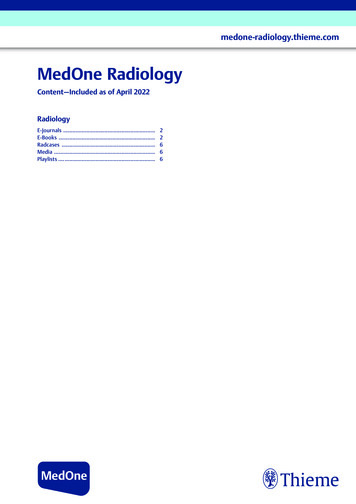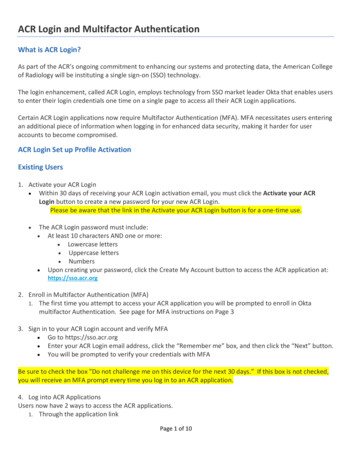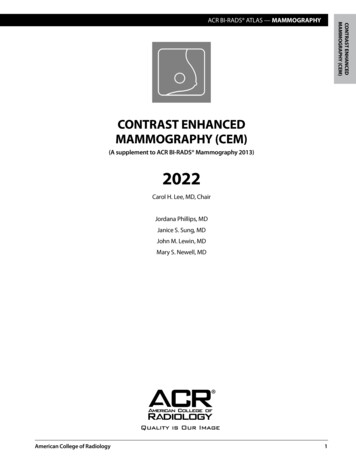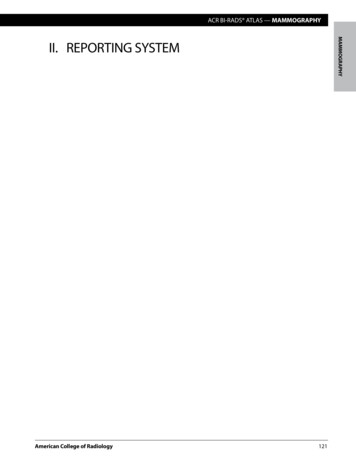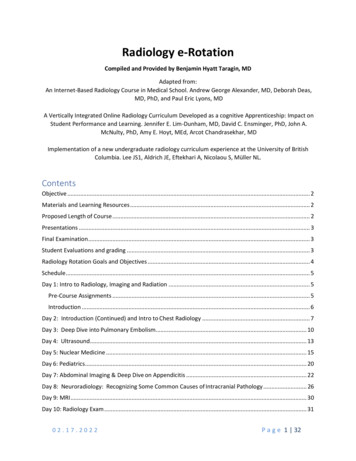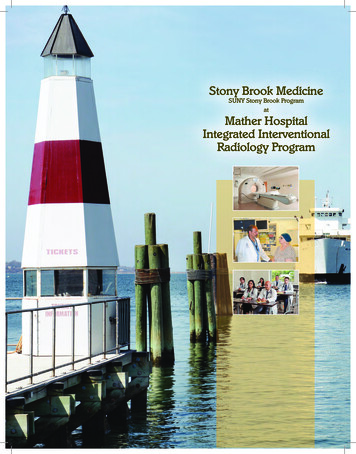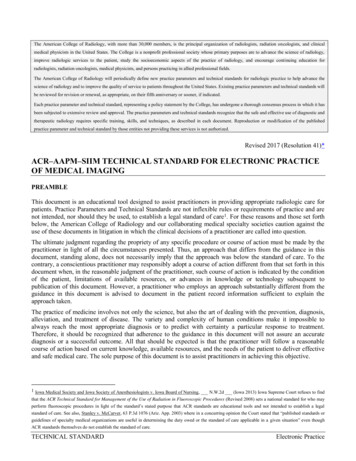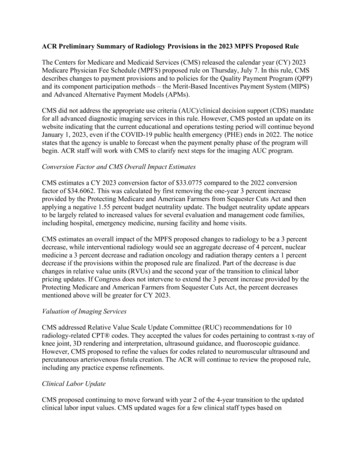
Transcription
ACR Preliminary Summary of Radiology Provisions in the 2023 MPFS Proposed RuleThe Centers for Medicare and Medicaid Services (CMS) released the calendar year (CY) 2023Medicare Physician Fee Schedule (MPFS) proposed rule on Thursday, July 7. In this rule, CMSdescribes changes to payment provisions and to policies for the Quality Payment Program (QPP)and its component participation methods – the Merit-Based Incentives Payment System (MIPS)and Advanced Alternative Payment Models (APMs).CMS did not address the appropriate use criteria (AUC)/clinical decision support (CDS) mandatefor all advanced diagnostic imaging services in this rule. However, CMS posted an update on itswebsite indicating that the current educational and operations testing period will continue beyondJanuary 1, 2023, even if the COVID-19 public health emergency (PHE) ends in 2022. The noticestates that the agency is unable to forecast when the payment penalty phase of the program willbegin. ACR staff will work with CMS to clarify next steps for the imaging AUC program.Conversion Factor and CMS Overall Impact EstimatesCMS estimates a CY 2023 conversion factor of 33.0775 compared to the 2022 conversionfactor of 34.6062. This was calculated by first removing the one-year 3 percent increaseprovided by the Protecting Medicare and American Farmers from Sequester Cuts Act and thenapplying a negative 1.55 percent budget neutrality update. The budget neutrality update appearsto be largely related to increased values for several evaluation and management code families,including hospital, emergency medicine, nursing facility and home visits.CMS estimates an overall impact of the MPFS proposed changes to radiology to be a 3 percentdecrease, while interventional radiology would see an aggregate decrease of 4 percent, nuclearmedicine a 3 percent decrease and radiation oncology and radiation therapy centers a 1 percentdecrease if the provisions within the proposed rule are finalized. Part of the decrease is duechanges in relative value units (RVUs) and the second year of the transition to clinical laborpricing updates. If Congress does not intervene to extend the 3 percent increase provided by theProtecting Medicare and American Farmers from Sequester Cuts Act, the percent decreasesmentioned above will be greater for CY 2023.Valuation of Imaging ServicesCMS addressed Relative Value Scale Update Committee (RUC) recommendations for 10radiology-related CPT codes. They accepted the values for codes pertaining to contrast x-ray ofknee joint, 3D rendering and interpretation, ultrasound guidance, and fluoroscopic guidance.However, CMS proposed to refine the values for codes related to neuromuscular ultrasound andpercutaneous arteriovenous fistula creation. The ACR will continue to review the proposed rule,including any practice expense refinements.Clinical Labor UpdateCMS proposed continuing to move forward with year 2 of the 4-year transition to the updatedclinical labor input values. CMS updated wages for a few clinical staff types based on
information submitted by stakeholders. The agency will continue to consider public commentrelated to wage updates for clinical staff during the remainder of the 4-year phase-in.Practice Expense Data Collection/MethodologyCMS is seeking public comment on strategies for updates to practice expense (PE) datacollection and methodology. CMS plans to move forward to a standardized and routine approachto valuation of indirect PE and they welcome feedback from stakeholders on what this mightentail. CMS provided some specific topics in the rule on which they are seeking comment. Theagency plans to propose the new approach to valuation of indirect PE in future rulemaking.Colorectal Cancer Screening CoverageCMS proposed to update coverage of colorectal cancer screening services to align with theupdated United States Preventive Services Task Force (USPSTF) recommendation to beginscreening at age 45 rather than age 50. In addition, CMS proposed to expand the definition ofcolorectal cancer screening to include a follow-on screening colonoscopy after a positive resulton a Medicare covered non-invasive stool-based screening test. CMS believes this would reducescreening barriers by ensuring patients will not be responsible for cost sharing for the additionaltest.The proposed rule does not make any mention of CT colonography for colorectal cancerscreening. CMS recently responded to the ACR’s formal reconsideration request that there is notsufficient evidence to support changing the current non-coverage determination for CTcolonography. The ACR will meet with CMS in the near future to discuss its rationale for thedecision.Medicare Shared Savings ProgramCMS proposed changes to the Medicare Shared Savings Program (MSSP) that the agency hopeswill advance their overall value-base care strategy of growth, alignment, and health equity. CMSproposed to incorporate advance shared savings payments to certain new MSSP AccountableCare Organizations (ACOs) that could be used to address Medicare beneficiaries’ social needs.CMS proposed benchmark adjustments to promote more ACOs to participate and be successful.CMS proposed a health equity adjustment that would upwardly adjust ACOs’ qualityperformance scores to continue encouraging high ACO quality performance, transition ACOs toall-payer eCQMs/MIPS CQMs, and support those ACOs serving a high proportion ofunderserved beneficiaries while also encouraging all ACOs to treat underserved populations.Quality Payment Program (QPP)MIPS Value Pathways (MVPs)Within this rule, CMS is limiting proposals for traditional MIPS and focusing on further refiningimplementation of MIPS Value Pathways (MVPs). Five new MVPs are proposed and sixpreviously established MVPS are revised. CMS is providing a means to provide feedback on
MVPs on the QPP website. CMS MVP proposals include changes and clarifications to MVPmaintenance and participation options, as well as several additions and revisions to subgroupreporting such as eligibility, registration, and scoring.MIPS Scoring OverviewThe category weights for the 2023 performance year are proposed to remain the same as the2022 weights: Quality – 30%, Cost – 30%, PI – 25%, and IAs – 15%. These percentages arelikely to remain fixed for the future of the MIPS program.The proposed rule continues to offer category reweighting for physicians who are unable tosubmit data for one or more performance categories. In most cases, the weight of thesecategories will continue to be redistributed to the Quality category.Beginning with performance year 2022, CMS began calculating the MIPS performance based onprior years’ mean and/or median scores. In 2022 this threshold was set to 75 points; CMSproposed to maintain the performance threshold at 75 points for 2023. This is based on therounded mean final score from the 2019 performance year.CMS will also no longer offer an exceptional performance adjustment beginning with the 2023performance year. This was previously finalized in the 2022 MPFS final rule. CMS finalized thepayment adjustment of /- 9% for performance years 2020 and beyond. No changes have beenproposed to the MIPS adjustment.Low-Volume Threshold and Small Practice (15 or fewer eligible clinicians) ConsiderationsCMS has not proposed any changes to the low-volume threshold criteria as previouslyestablished. To be excluded from MIPS in 2023, clinicians or groups would need to meet one ofthe following three criteria: have 90K in allowed charges for covered professional services,provide covered care to 200 beneficiaries, or provide 200 covered professional servicesunder the Physician Fee Schedule. CMS proposed no changes to the opt-in policy establishedwhich allows physicians who meet some, but not all, of the low-volume threshold criteria to optin to participate in MIPS.CMS is maintaining the small practice bonus of 6 points that is included in the Qualityperformance category score. CMS also continues to award small practices 3 points for submittedquality measures that do not meet case minimum requirements or do not have a benchmark.Quality CategoryAs established in previous rules, this category will be weighted at 30% for 2023 and likely forthe remainder of the MIPS program. As established in the 2022 MPFS final rule, beginning withperformance year 2023, CMS will change the scoring range for benchmarked measures to 1 to 10points, eliminating the 3-point floor; second, they intend to score non-benchmarked measures at0 points even if data completeness is met. New measures will continue to be scored at aminimum of 7 points for their first year and a minimum of 5 points in their second year. Thesenew measures will still be able to achieve higher points if a same-year benchmark is established,
but if a benchmark isn’t established after 2 years in the program, that measure will not achieveany points. The exception to this rule is small and rural practices, who will be awarded 3 pointsfor measures which either do not have a benchmark or do not meet case minimum.CMS has proposed the removal of the following measures: #76: Prevention of Central Venous Catheter (CVC)-Related Bloodstream Infections #110: Preventive Care and Screening: Influenza Immunization #111: Pneumococcal Vaccination Status for Older AdultsCMS has also proposed the addition of the following new measure to the Diagnostic Radiologyand Radiation Oncology measure sets: #TBD: Screening for Social Drivers of HealthNo changes to Quality measure data completeness requirements were proposed for 2023, soquality measure submission must continue to account for at least 70% of total exam volume. Thisnumber defines the minimum subset of patients within a measure denominator that must bereported. However, CMS proposed to increase this threshold to 75% beginning with the 2024and 2025 performance years.Cost CategoryCMS will continue to weigh the Cost performance category at 30% for MIPS performance year2023 and likely for all subsequent years. CMS proposed to add the Medicare Spending PerBeneficiary (MSPB) Clinician cost measure as a care episode group alongside the episode-basedmeasures already established as part of the Cost category.Improvement ActivitiesCMS will maintain the 15% weight for the Improvement Activities (IAs) category. The 2023Proposed Rule also adds 4 new activities and removes 5 previously adopted activities.The IAs proposed for addition are: Adopt Certified Health Information Technology for Security Tags for Electronic HealthRecord Data Create and Implement a Plan to Improve Care for LGBTQ Patients Create and Implement a Language Access Plan COVID-19 Vaccine Achievement for Practice StaffThe IAs proposed for removal are: IA BE 7: Participation in a QCDR that promotes use of patient engagement tools IA BE 8: Participation in a QCDR that promotes collaborate learning networkopportunities that are interactive IA PM 7: Use of QCDR for feedback reports that incorporate population health IA PSPA 6: Consultation of the Prescription Drug Monitoring Program IA PSPA 20: Leadership engagement in regular guidance and demonstratedcommitment for implementing practice improvement changes
Promoting Interoperability CategoryThe Promoting Interoperability category will continue to be weighted at 25% of the overallMIPS score, with reweighting options for non-patient facing clinicians and small and ruralpractices.CMS proposed several modifications to Promoting Interoperability objectives and measures forparticipants reporting this performance category, including expansion of the ElectronicPrescribing Objective’s Query of Prescription Drug Monitoring Program measure, addition of anew alternative “yes/no” attestation measure for “Enabling Exchange under the TrustedExchange Framework and Common Agreement (TEFCA)” under the Health InformationExchange Objective, and consolidation of prior compliance options for the Public Health andClinical Data Exchange Objective.Additionally, CMS has requested stakeholder comments on policy levers to advance informationexchange through TEFCA-participating health information networks.Advanced Alternative Payment Models (APMs)An Advanced APM is an APM that: 1) requires participants to use certified electronic healthtechnology (CEHRT), 2) provides payment for covered services based on quality measurescomparable to MIPS, and 3) requires participating entities to bear more than nominal financialrisk or participate as a Medical Home Model.For payment years 2019 through 2024, Qualifying APM Participants (QPs) receive a 5 percentAPM Incentive Payment. Starting in payment year 2026, the update to the PFS CF for QPs willbe 0.75%. The Consolidated Appropriations Act, 2021, froze the APM payment incentivethresholds for performance years 2021 and 2022 (payment years 2023 and 2024). Afterperformance year 2022, which correlates with payment year 2024, there is no further statutoryauthority for a 5 percent APM Incentive Payment for eligible clinicians who become QPs for ayear. Beginning in payment year 2025, the statutory incentive structure under the QPP foreligible clinicians who participate in Advanced APMs stands in contrast to the incentives forMIPS eligible clinicians.CMS is concerned that the statutory incentive structure under the QPP beginning in the 2023performance year and corresponding 2025 payment year could potentially lead to a drop inAdvanced APM participation, and a corresponding increase in MIPS participation as eligibleclinicians may believe their payments would be higher if they receive the MIPS paymentadjustment. CMS concluded that it would be more prudent to forego administrative action for the2023 performance period and 2025 payment year, and instead to seek robust public input thatCMS will consider in identifying potential options for the 2024 performance period and 2026payment year of the QPP.APM Entity ReportingCMS proposed to introduce a voluntary reporting option for APM Entities to report thepromoting interoperability performance category at the APM Entity level beginning with the2023 performance period. CMS has also asked for comments regarding sunsetting the use of
APM Entity level QP determinations and instead making QP determinations at the individualeligible clinician level only.CMS proposed to apply the 50 eligible clinician limits to the APM Entity participating in theMedical Home Model based on the TIN/NPIs on the APM Entity’s participation list. Similarly,CMS also proposed to apply the 50 eligible clinician limit directly to the APM Entityparticipating in Aligned Other Payer Medical Home Model and Medicaid Medical Home Model,and to no longer look to the parent organization for the APM Entity.APM Incentive Payment RecipientUnder the QPP, an eligible clinician who is a Qualifying APM Participant (QP) for aperformance year earns an APM Incentive Payment, which is made in the correspondingpayment year for payment years 2019 through 2024. CMS seeks comment on the proposal toamend to change the cutoff date for response to the public notice from November 1 to September1 of each payment year, or 60 days from the date on which CMS make the initial round of APMIncentive Payments, whichever is later.Request for Information Regarding the Transition from APM Incentive Payments to theEnhanced PFS Conversion Factor Update for QPsCMS has requested regarding the gap in statutory financial incentives for QPs in the 2025payment year, and the difference in potential financial incentives between QPs and MIPS eligibleclinicians in payment years beginning in 2026.CMS published Fact Sheets on the overall MPFS proposed rule, the Medicare Shared SavingProgram, and the Quality Payment Program.ACR staff will review the entire MPFS proposed rule in the coming weeks and will provide acomprehensive summary of the rule. The ACR will also submit comments to CMS by thecomment period deadline.
including hospital, emergency medicine, nursing facility and home visits. CMS estimates an overall impact of the MPFS proposed changes to radiology to be a 3 percent . CMS addressed Relative Value Scale Update Committee (RUC) recommendations for 10 radiology-related CPT codes. They accepted the values for codes pertaining to contrast x-ray of
